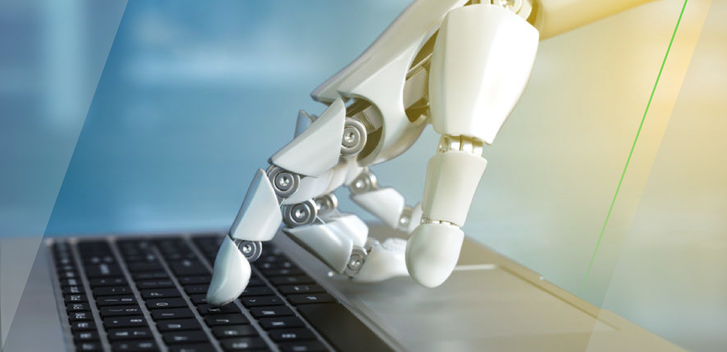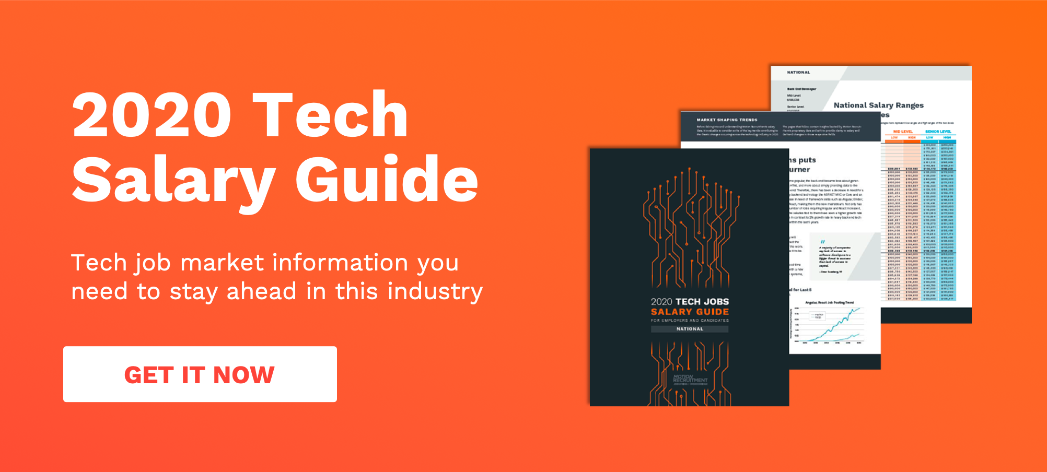It's no secret that technology is evolving rapidly, which can make keeping up with the latest trends a daunting task. Two decades ago, the "World Wide Web" was a chimera; today, nearly half the world's population can access the internet from their pocket. As visionaries like Steve Jobs and Elon Musk, and companies like Amazon and Google, compete to hurdle tech's capabilities forward, the 'next generation' of tech arise on a more frequent basis.
Besides becoming a full-time tech blogger, how can anyone stay fully in-the-know?
To help you stay on the cutting edge, our team assembled all the latest trends, from Artificial Intelligence to Zero-Knowledge Proof and everything in between. Keep reading to see the latest and greatest tech trends from A-Z.
Artificial Intelligence
The recent AI boom unleashed the potential for machines to think and learn autonomously – which many believe foreshadows a Terminator-like demise for mankind. In fact, scientists at MIT predict that these machines, which combine bulk data with immediate, algorithm processing, will outsmart us at virtually everything in the next half-century.
If that sounds too futuristic to be true, the proof is in the profit; after reaching a value of $1.5 billion in 2016, AI software is projected to reach $60 billion by 2025. For skilled AI developers, annual salaries range between $300,000 to 500,000. For the foreseeable future, it can dramatically enhance our businesses and lives – unless that's what the machines want us to think.
Blockchain
Aren't you relieved we didn’t say Bitcoin?
As the fate of cryptocurrency hangs in uncertainty, the peer-based tech, decentralized platform on which it is built, is proving market fortitude.
We've traditionally relied on databases owned by private companies to store our information – relinquishing control over our sensitive, saved data including bank details and health records. Blockchain is regarded as the backbone to a new type of internet, the solution to increased security breaches and consumer distrust.
Follow the money: since 2012, VC's have invested more than one billion into blockchain, with a significant interest in banking and financial sectors – which stand to save up to $12 billion each year by incorporating blockchain into their technology.
Cybersecurity
Last year, Equifax's infamous breach shed light on the intense, global demand for better cybersecurity. Cyber-crime damage costs are likely to exceed $6 trillion by 2021, which will open 3.5 million unfilled cybersecurity jobs – a fairly safe bet for a sustainable career.
Today, there is already a hack every 39 seconds, affecting a 1/3 of Americans each year. The number of devices in our home that are 'smart' or Internet of Things-based has only enhanced this threat to our private information.
Since there will be up to 200 billion of these connected devices by 2020, you should start brushing up on your risk-analysis skills today.
Data Scientist
Following the Big Data craze, companies found themselves wallet-deep in analytics, of which they lacked the skills to find interpret meaningfully. This bottleneck spurred the demand for Data Scientists, capable of performing analysis, engineering, and modeling to derive meaningful results from proprietary data. Field specialists are uniquely suited to drive productivity, efficiency and growth for their organization.
Not sold yet? Data Scientists report an 88% job satisfaction, likely enhanced by the meaningful nature of their work. Plus, the recent Cambridge Analytica-Facebook scandal, in which sensitive data of more than 85 million users was manipulated, proves just how potent data can be when harnessed effectively.
Edge Computing
Surprised you haven't seen 'cloud' listed? That's because Edge Computing is creating a full-on tech storm. Cloud platforms can handle large amounts of data, but lack the bandwidth imperative to work with all IoT devices. Edge computing can reduce latency delays and costs while improving network efficiency.
The frontier of computing will steer away from centralized nodes to a networks' logical extremes – enabling analytics to be gathered at the data's source. Actions can be completed within a few milliseconds, rather than a few hundred milliseconds.
While this contrast seems trivial for Alexa, it can mean life or death when sending data to and from driverless cars. But with Telsa and Apple, and endless VC's, channeling their energy into producing this technology, we can expect to see it coming soon to devices near you.
Facial ID
Once a mainstay of Sci-Fi movies, facial recognition iapps going mainstream. While iPhone X users can't stop promoting the convenient feature, this year will bring Facial ID into our pockets. Biometric solutions to security threats will be featured in mobile devices and standard video systems and more.
Think different? Looking toward the future, Apple recently announced a $390 million investment into this development, essential for enhancing their portrait mode, animoji, true depth features and more.
(5) G
Verizon is dominating headlines with their 5G service, touting improved wireless speeds, data capacities and fewer delays. Smartphones with 5G will be available in 2019, but tech companies are clamoring to invest and claim ownership this year. Google is currently testing solar-powered drones that can stay up in the sky for as long as five years and beam down 5G signals to users.
So, how fast is 5G? A two-hour movie took 26 hours to download on 3G, six minutes on 4G and a mere 3.6 seconds with 5G. This speed will enable a world of wireless communication that brings us closer to a wholly 'smart' planet. With this amazing new capability, only one question remains: can you hear me now?
Health Sensors
The rising health costs and the growing senior population are the driving forces behind Health Sensors, which have the potential to catch medical abnormalities faster than before. Enabled by wearable tech, sensors can increase the intelligence of life-supporting implants and sensors can be employed for identifying advanced symptoms and preventing serious illnesses.
But, what is on the inside is most important; many industry-leading HealthTech firms have been testing embedded devices to collect health metrics like electrocardiogram movements and blood pressure readings.
Internet of Things (IoT)
Alexa, what's IoT? IoT encompasses smart, connected products like smart phones and smart watches and vehicles. The future of personal assistants and smart home products means this technology will sync to almost every facet of your life.
With more than $800 billion spent on IoT markets globally, and more than 60% of global manufacturers using IoT-sourced analytics, it's predicted there’ll be 75 billion connected devices by 2020.
The drawback of these devices is their poor security – creating a symbiotic market for cybersecurity for privacy and the edge computing networks imperative to making them work effectively. Now, if we can only get them to stop laughing at us....
JavaScript
No, this isn't Starbucks' new signature font. Primarily used for large volumes of web page coding, almost every internet browser today is based on JavaScript. For web and app developers, it is an imperative skill on today's market. So while it is not new – it has proven permeability in the tech world. For Front End Developers passionate about shaping user experience, JavaScript is considered the sharpest tool in their belt. With extensions like React and Redux increasing in popularity, JavaScript is a must-learn for all coders.
Kotlin
Now the official development language for Android, Kotlin is considered the most-loved language by programmers. The 'pragmatic language' is being adopting quickly by traditionally Java Developers because it has 100% interoperability with their existing frameworks.
Plus, Kotlin's null-safe language is rapidly being adopted in Silicon Valley because offers a smarter way for sever-side development. If it didn't sound versatile enough, Kotlin can be used in both Object Oriented and Functional Programming styles. With this level of klout, Kotlin is set to take over this year.
Li-Fi
This new light-based wireless connection with data speeds 100 times that of Wi-Fi, will bring high-definition virtual objects into stores. Traditional Wi-Fi's maximum data rate is 7Gb/s, but can go beyond 100 Gb/s.
LED lights can be harnesses to share and receive data while lowering internet traffic congestion. Li-Fi is also more secure; because light cannot penetrate walls, it is nearly impossible to hack into sensitive data transmitted on this network. With data confined to a room, it becomes more secure. Don't take our word for it – check out the Ted Talk where it was first introduced.
Machine Learning
Give a man a fish, feed him for a day. Teach a man to fish, feed him for life. This famous proverb drives the concept behind Machine Learning; building something to be intelligent enough to function autonomously. Machine Learning is imperative for the development of computer programs that can learn new information automatically and find hidden insights in complex data. These analytics can be used to predict customer behavior, figure out the optimal time to sell a stock, or suggest business strategies that the human mind is unlikely to create.
For companies looking to upgrade their technology while tightening their belt, Machine Learning is the perfect solution. Netflix saved more than $1 billion this year due to their ML algorithm which helped recommend content for subscribers.
As larger companies have begun to adopt this technology, it is quickly becoming popular among tech startups. It's no surprise that machine learning as a service (MLaaS) will be worth more than $20 billion by $2025.
A step beyond Machine Learning, NLP is the computer's ability to analyze, understand and generate human speech. This in-demand skill for application developers working on AI apps with sub-skills including Python, Java, C++ and Spark.
Natural Language Processing paves the way for us to communicate with computers using normal, everyday language, slang, and tone. With the help of NLP, people will be able to ask computers questions naturally and receive answers with more accurate insight to each query.
This shift part of the larger trend evolving us further from screen and keyboards, and into a world where voice-assisted services like Alexa and Siri are King (or more accurately, Queen).
We know that open source has been around for more than 20 years, but the concept of the open source software is more topically relevant than ever before. As privacy and monitoring scandals increase globally, Open Source Development strives to prevent abuse of the ideals and ethos that are pertinent to this movement.
Android is one of the most-known open source platforms, a decision which has increased trust around their brand as opposed to the top-secret iOS code. The larger market is trending toward open source, as demonstrated by one of the largest open source cloud giants, Cloudera, that recently filed to grow public.
Prescriptive Analytics
Not to be confused with your last eye exam, Prescriptive Analytics is one of the most advanced iterations of big data. These analytics harness a variety of algorithms to offer recommendations for an optimal future outcome based on historical data.
In the next year, we'll see companies begin adopting this technology, following companies like General Electric and DSW, which have already done so to drive their businesses forward.
Predictive analytics enables:
- Quality improvements
- Service and productivity enhancements
- Cost reduction
Quantum Computing
Few of these listed advancements would be tangible without the developments in computing power. From 1975- 2015, the power doubled every two years, then plateaued. The quantum computer promises to be millions of times faster than computers today. As opposed to traditional binary 'bits' (1 & 0), which can exist in both states simultaneously.
Tech leaders are actively racing to launch the first commercially viable quantum computer, capable of solving problems that today’s computers can’t handle, and problems that we can’t even imagine, yet.
Robotics
One large step for man, one giant leap for robot-kind. As artificial intelligence gains popularity, robots become more intelligent, efficient, and valuable to humans. While artificial intelligence replaces our digital interactions and calculations, robotics will replace our manual actions, like carrying heavy groceries, cleaning homes and even exercising pets.
Essentially, any repetitive roles that human have, like assembly lines, will be replaced by robotics. But one question remains; with one robot running your house and the other doing your job, what's left for us?
Software as a Service (SaaS)
More competition means companies need better customer service. If you don’t answer quickly or provide good service, they’ll go to a competitor. The SaaS industry has been traditionally focused on broader business functions like HR, CRM, accounting, etc.
According to Cisco's Global Cloud Index 2013-2018, almost 60% of all cloud workflows will be delivered as SaaS by the end of this year. Why the rise in popularity? Companies are seeing tremendous financial savings after converting from legacy-based systems. In fact, 38% of US businesses started fostering a SaaS-exclusive workplace in 2017, more than double the amount from the year prior. SaaS will likely continue its upward trend, as it is predicted to hit a public market value of $76 billion by 2020.
TensorFlow
Following recent open source trends, Swift for TensorFlow has recently become open source via GitHub. At TensorFlow's Developer Summit in March, many engineering fields have been harnessing TensorFlow for incredible feats, including:
- Astrophysicists analyzing massive amounts of data from the Kepler planetary mission
- Medical researchers assessing a person's cardiovascular risk
- Air traffic controllers predicting flight routes in congested airspace
- Scientists in Africa detecting plant diseases to help farmers' yield rates
User Interface (UI)
With the growth of smart speakers and voice command, it is often unnecessary to look at a phone or computer to input data. Plus, as desktop devices are nearing obsolete-status, we’re approaching an inevitable overhaul in traditional user experiences. Expect to see new types of visual and audial cues as part of next-gen UI, including context-awareness, sensors and multimodal output capabilities. If you speak with Alexa or Siri, you are already using 'Zero UI' design, leveraging computer vision, voice control and haptics for a seamless interaction.
Virtual Private Networks
VPNs are as old as the internet but is in the limelight as cybersecurity threats increase. VPNs allow users to mask their online identity by securely diverting all your web traffic so it appears you're searching the web as if you were in a different country. This real-life invisibility cloak makes it almost impossible for anyone to monitor their online activity.
So, why use VPN?
- 31% of VPN users use it to browse anonymously
- 30% use it to unlock content like Netflix
- 25% of internet users use a VPN network (42% of whom use it daily)
Wireless Charging
Power cords are like leashes for adults in the digital world. Rather than being tethered to the wall as your phone charges, brands like Powercast and Energous unveiling chargers that send power to multiple devices over the air. Headphones aren't far behind; smartphone makers are ditching headphone jacks for good, which is why sleek over-ear headphones to tiny buds that look like gemstones will be everywhere in the coming year -- so get ahead on your holiday wish list now.
Extended Reality (XR)
XR refers to the spectrum of experiences that blurs the line between the real world and the simulated world -- such as virtual and augmented reality. The technology immerses the user through visuals, audio, and haptic cues. XR is removing the hurdle of distance, increasing access to people, information, and experiences.
Y Combinator
If you live in (or watch HBO's) Silicon Valley, you know that incubators are one of the most effective way for small startups to grow into the tech giants they aspire to become. An incubators success is only measured by that of its’ startups. Y Combinator has gained a renowned reputation for being one of the best; their graduates include Reddit, Stripe, Airbnb and Dropbox. With a 7% equity in each of their clients, their value and reputation continues to skyrocket.
The incubator is named after the mathematical recursive function, which performs itself as part of its total operation and is an essential part of computer programming. Since 2005, Y Combinator has funded more than 1,500 companies and their alum are valued over more than $1 Billion.
Zero Knowledge Proof (ZKP)
This blockchain-based capability is a method used in cryptography to prove ownership of a specific piece of knowledge without revealing the content of that knowledge. ZKP enables transactions that safeguard users’ privacy and improves verification; one party can prove to another that a given statement is true, without revealing anything about the statement.
As online privacy becomes a more prevalent debate, this technology provides a solution to make our information a little more private again.
Final Thoughts
There are few that could have predicted at the turn of the 21st century what tech trends would be prevalent today; as of a decade ago, many of these terms like "edge computing" and "blockchain" hadn't even been mainstream language – if even ideas.
As we consider the rapid rate at which tech trends have evolved in the last 20, or even two years, it is exciting – if not daunting – to consider how this will escalate in the coming decade.
While there is no way to know for sure what trends will pop up, you can count on us to be sharing the latest with you.

Motion Recruitment









